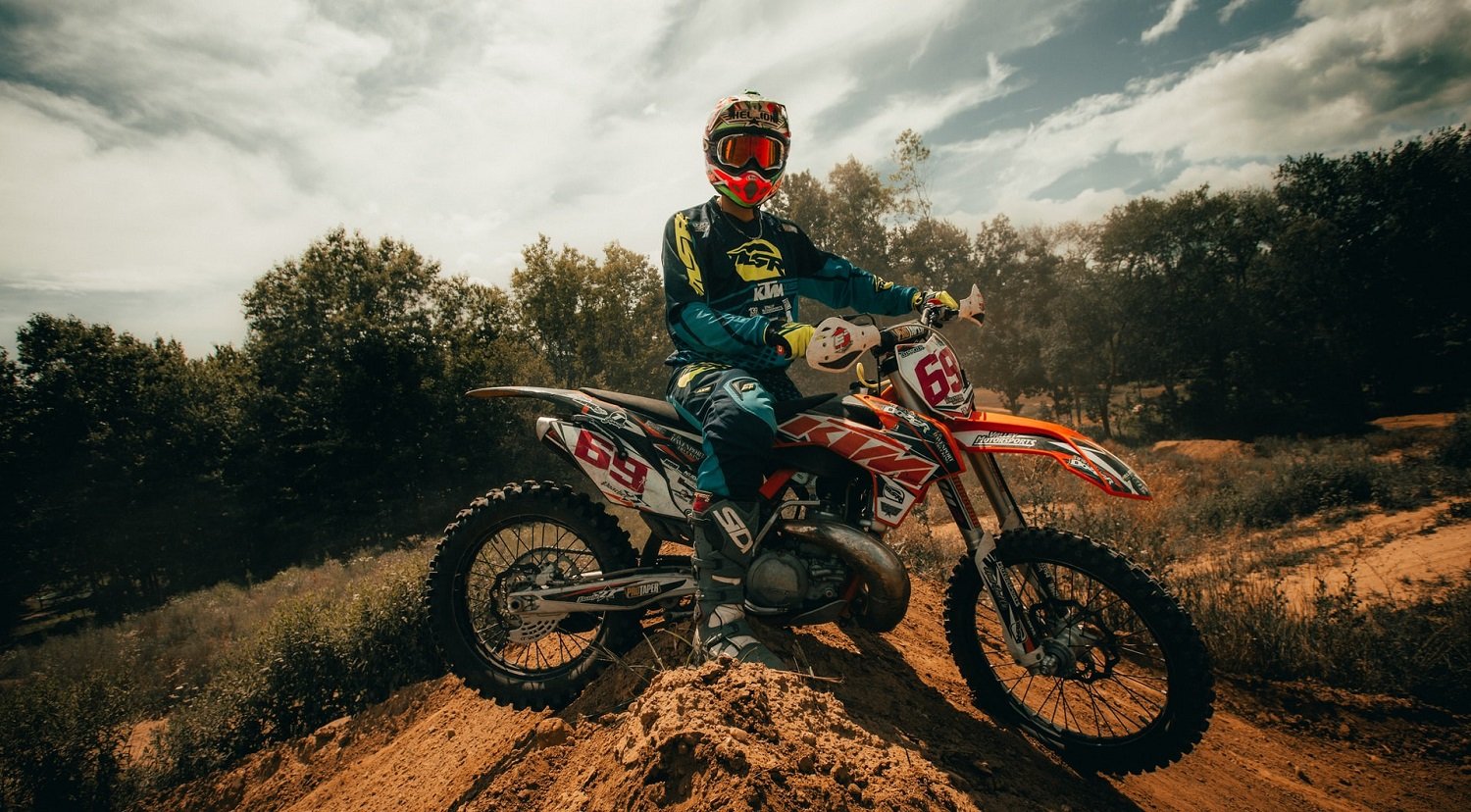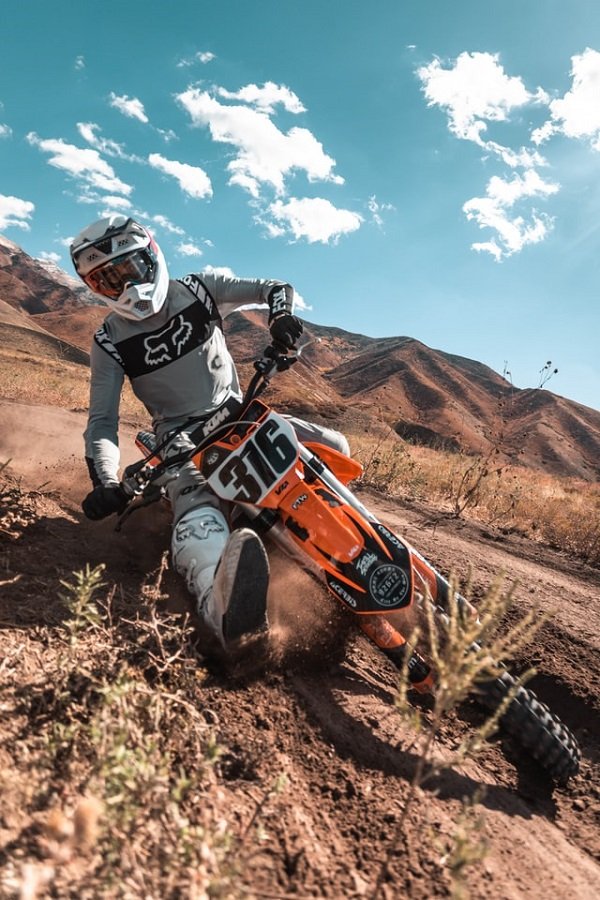How to ride a dirt bike
Updated on | By Mohit Chauhan

Riding a dirt bike is a passion for many, and one that attracts us from an early age. Is it because of the dirt, or because of the thrill we get from revving the engine? Probably the mix of both!
So, like any other beginner, you may have started out with a 50cc dirt bike in your backyard and are now thinking about taking up your biking skills to the next level. You are obviously in the right place to learn the right techniques.
For those of you looking for expert advice on how to get started, you may have already purchased your dirt bike and the right safety gear. Or at least you’re thinking about it.
Read more here: Best dirt bikes for beginners
To start out on a dirt bike, the best way to prepare yourself is to practice on a mountain bike (bicycle). Choose a dirt track with bumps and bends to familiarize yourself with this type of terrain. Do small jumps, work on your posture and improve your speed.
Not only does it give you an idea about the terrain, a mountain bike trains your body for a series of physical challenges that you may come across. Similar to skipping rope which is usually done by athletes, when you’re not practicing on a dirt bike, you should be on your bicycle. Because motocross is a very demanding sport that requires a lot of training and fitness. Some of the greatest champions of motocross practice mountain biking whenever they get the opportunity to do so.
Now that you’ve procured your dirt bike and are all padded up after few weeks of exercise and training, you can hit the trails. Find the closest dirt track in your area, assuming you are not lucky enough to own a large piece of land 😐
In any case, look for a track that has at least one beginner-friendly trail.
Step by step guide to dirt bike riding
Choose the right bike
Many beginners end up buying a dirt bike that is not right for them. Either due to the fear of running underpowered or simply to make a statement.
This however results in a lot of frustration when it comes to learning basic riding skills. Heavy or professional dirt bikes are extremely difficult for beginners and are much harder to handle at low speeds. In addition, the tremendous power of the engine can cause the rider’s muscle to ache which eventually drains the last ounce of energy.
It is therefore advisable to always start with smaller displacement classes. A 250cc dirt bike is more than enough for a newbie with an average built (less than 100 kilograms) till the time he decides to take dirt biking professionally.
Maintain a proper posture
Maintaining a proper seating position is extremely important while riding a dirt bike. As you sit on the bike, your feet are supposed to be ‘just’ touching the ground. Move as much towards the front of the seat as possible; many beginners often choose to sit too distant from the handlebar for comfort. However, the ideal position is to sit upright close to the front where the seat meets the fuel tank.
Position your head and elbows the right way up
The position of your head should be on the longitudinal axis of the bike at all times without any significant movements, even while standing. Doing so keeps you in the center of the bike and allows you to work from there. Another important consideration is the position of your elbows, which must be kept high and pointing away from your body. Only then can you properly utilize the strength generated from your shoulders.
Use your legs more than your arms
One common mistake made by almost every beginner rider is riding too much using their arms and thereby losing a lot of energy in the process. While riding a dirt bike, the legs should do most of the work. Grip your knees around the bike and place a firm pressure on both footrests with your feet.
Adjust the levers
Incorrectly adjusted brake and clutch levers can cause fatigue since you cannot grip the controls properly or have to exert too much pressure to operate them correctly.
It is recommended they be slightly tilted downwards. Although, depending on your height, this may vary. Experiment with different positions from time to time to see which position works best for you.
Same goes for the gear and brake levers. Make sure you have them properly adjusted before you go on your first ride. The footrest and the brake lever should form a horizontal line, or you may place the shift lever slightly higher than the footrest, allowing you to get your boot underneath it to shift up.
Hold the brake & handlebar together
While this may sound obvious to you, but when dirt biking, your hands should be completely gripping the handlebars. When you want to brake, one or two fingers are all you need to get enough stopping power. Using more fingers to do it may prevent you from gripping the handlebars properly, and you may fall.
Here you have the following options: While holding the handlebars with both hands, always have one or two fingers on the brakes to be able to react quickly. Surely the whole thing also depends on where you are moving and in which style you are riding. For instance, if you are riding downhill and constantly need to brake or adjust your speed, then it is definitely an advantage to have one or two fingers on the brake at all times. But if you’re riding freestyle and performing stunts, then you might want to hold on to the handlebars completely for extra control over the bike. Still, its best if you can master both variations.
Learn to corner
Riding fast through corners is an art in itself. But the problem is that every corner is different, so you always have to adapt to it accordingly. To simplify the process, there are a few basics you should keep in mind.
Most likely, you may have heard the phrase, “Look where you are going, because you will inevitably end up where you are looking”. In other words, be sure to look as far into or out of the corner as possible and plan down the course you will subsequently be following.
Tip: While approaching, if you realize that the curve is tight, you can often increase the radius of the curve by approaching from the outside (the best route is not necessarily the one with the most tire marks).
Overcome fear
One of the important factors to learn and take into consideration before riding a dirt bike is dealing with nervousness. By managing anxiety and heart rate you will be able to outperform in just few weeks of practice.
If you decide to take up this sport, you should keep in mind that adrenaline is a natural process of your body which helps you to prepare for this type of challenge.
However, severe anxiety should be addressed by a medical expert.
Tip: Take at least 20 minutes of physical exercise such as running or skipping rope to combat nervousness. Walking for at least 10 minutes on the track where you will be riding can also be a good way to lift your mood.
Learn gear shift techniques
While shifting gears, many riders swing their knees away from the gear lever to get underneath the gear shift lever.
Try upshifting while keeping your knee close to the tank pointing straight ahead. Not only will it use less energy, but it will also keep your bike stable under heavy acceleration. That said, when you are shifting in a seated position, the proper technique is to use your ankle while making the shift. This ensures a firm grip of your leg on the bike.
Tip: Do not abuse your clutch repeatedly while shifting. Even a half-pulled clutch is sufficient for gear shifts.
Never look behind
Often times, we have seen beginners keeping a watch on the riders coming from behind to make way for them. Although this is an act of benevolence, it can sometimes turn into a disaster. By changing lanes abruptly to make way for the faster riders, there is a risk of collision and fatal injuries.
Being a slower rider is no shame, however, it is advisable to maintain a decent speed on a dedicated lane. An overtaking rider is usually capable of dealing with beginner riders and won’t face much problem overtaking you.
Make sure you wear the right motocross gear

One of the biggest challenges while dirt biking is the uncertainty of track conditions that usually depends on the mud. The risk of falling increases considerably, especially during downpours. So before getting on your bike, we recommend investing in good protective gear and making sure you don’t compromise on safety.
These are the ideal outfits that should be worn while riding a dirt bike:
- Skid resistant and breathable outfit that covers the entire length of arms and legs.
- Boots specialized for off-road riding (preferably MX boots) with integrated shields and liners. These boots must have a high shaft to support the ankle and reduce the risk of injury to the ligaments in case of an impact.
- A good quality jacket that is capable of absorbing any impacts around the arms, elbows, shoulders, and back. An integrated full-length flexible spine protector should also come retrofitted, or at least the jacket should have inserts to add them after purchase.
- Padded motocross gloves to ensure a firm grip on the handlebars even at high speed.
- Neck Brace is equally important to protect and support the cervical spine during high-speed bumps.
- Pair of dirt bike goggles also comes in handy to protect the eyes from flying roost.
- And finally, the most important piece of gear; a good quality MX helmet (DOT or ECE certified only).But make sure that the helmet fits snugly, is not too tight, and doesn’t slip either. You can read everything related to size guide here: Choosing the right helmet size.
Shifting between gears
Gears on the dirt bike are engaged by the lever located on the left side of the bike. In order to engage the first gear (the starting gear), just push the lever down, and to engage all the other gears you have to push the gear level up in succession (or vice versa depending on the model).
Remember, however, that between 1st and 2nd gear there is neutral (i.e., there is no gear) in case you wish to park your bike.
In order to shift between gears, the clutch must be engaged, which is located on left side of the handlebar. Once the clutch is engaged, apply the first gear and gently release the clutch while simultaneously increase the throttle.
In order to understand when to shift to the next gear, simply keep an eye at the rev counter, which measures engine revolutions. Once the rev counter reaches the ‘yellow zone’, it is time to upshift! In few weeks, you won’t have to keep an eye on the engine revs as this will come naturally to you.
Tip: You can recognize the need to upshift or downshift by monitoring the engine sound.
Tips for riding a dirt bike safely

A dirt bike rider must understand the risks involved in this extreme sports. Truth be told, a biker is most vulnerable in the event of a fall or accident, which is why it is essential to understand both your as well as your vehicle’s limit.
There have been many dirt biking accidents that have ended up in the hospital. As a matter of fact, studies have indicated that an average of 25% of dirt bike accidents result in hospitalization of the rider. This further accentuates the dangers involved in this sport.
The most common injuries associated with dirt bike accidents are sustained on the lower part of the body. Then there are injuries to the upper body and finally to the head (which is the most dangerous one). Thus, the severity of possible injuries should not be ignored while riding a dirt bike.
So, the first thing you need to do is wear proper clothing. As a rule, while practicing on a dirt bike, it is recommended to prepare yourself beforehand in case of a fall or a collision. This includes wearing a full-face helmet, gloves, high ankle boots, chest and back protectors, motorcycle jacket, and riding pant. But keep in mind that the quality of these protective equipment does play a role in your safety. So, choose wisely!
A dirt bike wears out more quickly than a conventional motorcycle. Mud, gravel and small stones can damage critical components of your dirt bike. It is therefore necessary to check the state of your bike before and after each practice session. In addition, use the right set of tires recommended by the manufacturer and always inspect the air pressure before every ride.
Know the laws
Search for places in your area that are lawfully available for riding a dirt bike. Wandering around on your dirt bike can get you into trouble if you try to ride it on streets. Usually, dirt bikes are not road legal and thus only restricted to off-roading only. So, avoid making any assumptions that can land you a ticket.
To locate a dedicated track, it is best to do online research for the nearest dirt bike track in your neighborhood. Also, make sure you are either carrying your bike on a pickup or a trailer to the destination. A friendly dirt bike retailer in your state will surely help you out.
Essential Tips For Beginners
Riding a dirt bike can turn out to be really challenging sport and the learning curve can be pretty steep without some good sound advice. To help you out we have compiled a list of 10 basic tips that are essential for beginners.
- First essential step is to learn how to stand. Dirt bikes have a huge seating space but you need to learn to ride without sitting on it. So it is important to get your standing position right for an improved off road riding. This can be learnt by riding on a smooth flat road. Seek some help and ask them to film your ride so that you have an idea how you ride relative to what you should ride like. But do keep in mind, becoming self-critical about not being able to stand up well will turn out to be the biggest thing that holds you back. Instead, learn to control your own balance and weight relative to the bike so that when you are accelerating or decelerating or going through bumps, your balance is always maintained.
- Another thing that’s really important while sitting is not leaning too backwards on the bike. Also make sure that you do not have straight arms, and are not putting too much weight on the rear wheel.
- Next tip is to focus; essentially when we ride a motorbike we only look in the direction where we are heading, but it is important to plan and improvise while you are scanning the trail in your head. Take a glimpse every now and then of not just the immediate trail that is coming ahead but also the upcoming trail and improvise accordingly.
- Using the foot pegs to control the direction of your bike is a fundamental skill to off-road riding. If you put your weight towards the left foot peg, the bike will go left. Similarly, if you put your weight towards right foot peg, the bike will go right. The same concept applies to the handlebars as well. To really get some finesse, this is a useful tip.
- After you’ve got your basic positions correct, the next step is to learn to move with the bike in order to counteract the forces that are going on. So make sure you lean into the bike whenever you are accelerating, likewise make sure you lean away when you are decelerating.
- Learn to counteract the weight of the bike when you are riding off-road. Adjust your body weight around the corners to maintain the tire grip. Counter balance the weight of your bike with the help of your hips and legs to keep the bike upright while cornering.
- Work on your balance; a well balanced ride ensures you no longer need to touch the ground for assistance, and the best way to incorporate this in your riding style is by practicing at very slow speeds.
- If you are a short rider, always look for higher ground to put your feet on if you have to. This applies in the really technical terrain like big boulders and rocks. Look ahead and search for certain rocks where you can plant a foot if you need to. Ideally you want your bike to always do all the work but if you are in a position where you need to muscle your bike to readjust or move it around this is how you can do it.
- Use your legs rather than your upper body. This is particularly helpful for short riders as they may not have much leverage as others. Since legs are stronger than arms, it can help you a lot during lifts.
- In case you have a short inseam length, the best way to reach an uneven terrain is by slipping to the side of the bike by sliding your butt towards one side. This creates an additional reach for your leg which is useful to stabilize and balance your dirt bike.
Bottom Line
The only difference between a beginner and an expert is their riding technique. A beginner’s technique is similar to an amateur who is trying to balance on a tightrope. If he constantly looks down, the possibility of losing the balance increases significantly.
In other words, while riding a dirt bike, instead of fixing your eyes on the immediate ground next to your front wheel, keep an eye out in planning your route on the track. This allows you to adjust your riding position in time. As time goes by (and with regular practice) you will realize that you are a step ahead from where you left off as a beginner.
Lastly, riding a dirt bike can be difficult and challenging. Have confidence and don’t let your size or the size of the bike deter you from becoming a better rider. Anything can be done no matter what others might say! All it takes is practice and hard work.
Word of advice: Dirt bikes are strictly meant for off-road use only. As such, it is illegal to ride one on public roads and sidewalks even with a valid two-wheeler license. In order to reach your nearest dirt park, you may require a loading ramp to haul your bike at the back of a pickup truck. Or alternatively, you can utilize dirt bike trailers as well. But in no condition, should these be tested on the streets.
Good luck!




